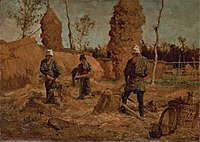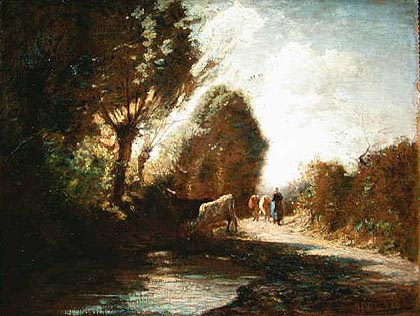Asai Chū
Chū Asai (Japanese浅井 忠; born June 21, 1856 in Edo, now Tokyo, † December 16 1907 in Kyoto ) was a Japanese painter. He is considered the most famous landscape painters of the Yōga, the influenced by the Western art painting of the Meiji period.
Life
Asai Chū was the son of a samurai of Sakura, a clan in Edo. He was a painter in the style of traditional Kachōga, the bird - and - flower painting is formed. However, he changed his technique, switched to oil painting and was recorded in 1875, which was founded by Kunisawa Shinkuro private painting school Shōgidō. Kunisawa Shinkuro had completed his painting training in London with the painter John Wilcolm and wanted to spread his knowledge by Yōga school. In 1876 he went to, which was founded in the same year Kobu Bijutsu Gakko, the Technical Fine Arts School, and became a disciple of the Italian Antonio Fontanesi. After this in 1878 left school, Asai Chū founded with ten other students of the Italian unification Jūichikai, the group of eleven.
In the following decade an increased disinterest in Yōga and especially the painter of Nihonga, the modern Japanese painting followed a traditional base, were known. Only in the 1880s awoke again for Yōga an interest by the return of several artists who had learned and studied in Europe and this knowledge could now be incorporated into the Japanese art. To 1888, the earliest landscape images Asai Chu, including today in Tokyo National Museum issued picture emerged Fields in Spring ( 1888). In 1889 he was among the founders of the Meiji Bijutsukai, a group of artists who later became the Taiheiyo Gakai ( Pacific Society for painting) and the first artist Organization of Japan was for western influenced art. 1893 returned to the painter Kuroda Seiki from Paris and brought the ideas of Impressionism and the plein- air painting to Japan. The Yōga artists were split due to this innovation in a conservative and a progressive camp. Asai Chū 1898, was appointed to the Tōkyō Bijutsu Gakko, today's Tokyo National University of Fine Arts and Music, attended by Kuroda Seiki taught. Asai was in this position, the representative of the conservative Yōga, although he recorded impressionistic influences in some images.
1899 Asai Chū got a scholarship from the Mombushō, the Japanese Ministry of Education to study painting in France. He traveled according to 1900-1902 to Europe and shuttled between Paris and the suburb of Grez -sur -Loing, which he in his painting Autumn in Grez -sur -Loing (1901, Tokyo National Museum ) held. He also traveled to Italy, Germany and England, returning only then to Japan, where he accepted a teaching position at the Kyoto Kōtō Kogei Gakko ( Kyoto School of Design) newly founded. He was the first official teacher of Yōga in the culturally conservative city Kyoto, from the style then spread over the western Japan. 1903 opened Asai his own private school in Kyoto, which he called Shogoin Yōga Kenkyujo ( Shogo Institute of Western Art ) and the 1905 was Bijutsuin Kansai ( Kansai Art Institute ). Among his most famous pupils included Ishii Hakutei, Yasui and Umehara Sotaro Ryuzaburo. In addition to his painting, he was also a book illustrator for woodcut templates action, in particular in 1907, the year in which he died, published tosei fuzoku Gojuban uta awase ( Collected poems of fifty views of Western manners ) was very well known.
Image selection
Sewing Woman
The Village Kotaba
Pulling Boat










